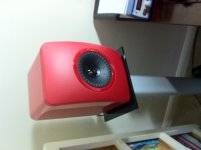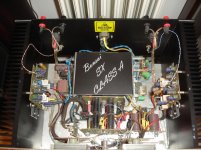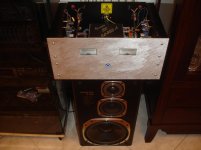Must be cold. Very cold. Not like the English warm beer - terrible.
You mean the ones that take 20 minutes to pump?
@hahfran
@Bonsai
Otherwise where could the problem lie ? All the 4 boards show the same issue... Try to exchange A1381 and C3503 transistors with unmatched (rating E and D) Mouser's ones at least on one of the boards ?
@Thimios
The the coil inner diameter must be the bit shaft diameter. If you press the wire firmly on the shaft while winding, the coil is wound tight on the shaft.great idea but how to control or determine the coil diameter ?
@Bonsai
all the transistors have their labelled side facing upwards, the picture doesn't show it properly. Should I post new voltage measurements with let's say R20=5.6k ?You definitely have a problem Sadhill - with 2.2k you should not blow any fuses
Otherwise where could the problem lie ? All the 4 boards show the same issue... Try to exchange A1381 and C3503 transistors with unmatched (rating E and D) Mouser's ones at least on one of the boards ?
@Thimios
Yes you remember well, it is playing undistorted music, but I guess with a limited though quite comfortable power. I could live with it if I was sure the SQ isn't affected with the present issue.after the accident you must check some parts like output trans.but if my mind serve well you speak about a working amplifier.
Last edited:
the 1381/3503 pair ist one of the best choice for VAS as these feature Cob 3 pF and even more important Reverse Transfer Capacitance 2.3pF but alas ...discontinued since year 2011 so which other choice ? 2SC2690A 2SA1220 A is apparently discontinued.too? NTE2501/2502 is offered as replacement has significantly lowr fT , however.
Fairchild makes versions of these (KSC2690/KSA1220) which are current production. 🙂2SC2690A 2SA1220 A is apparently discontinued.too?
/U.
I tried to solder 10k in parallel on R1 to get R1=5k. It allows to adjust the offset to 0mV, but this one gets very unstable (+10mV to -10mV) when heatsink is hot (60°?), still with +/-25V/1.25A on the rails. The other measurements are not much changed, namely Q1Q2 emitter to emitter voltage remains low (414mV instead of 700 on Thimios's schematic).
I think I'll try to swap the 1381/3503 pair tomorrow for Mouser's.
I think I'll try to swap the 1381/3503 pair tomorrow for Mouser's.
Had similar problems earlier. Drifted alot. Sourced 2sa1360/2sc3423 from a local supplier which I thought were ok. They were not. Probably fake. Got "real" ones and everything was ok.
I can't see any protection circuit in your amplifier,i wonder always about my speaker safety😱My sx-Amp is still looking good. I am using a pair of Q Acoustics 3020 that my wife bought me with my amp in my office. I listen to a lot of Yo-Yo Ma, Bill Frisell etc on it.
😎
when the lo bias setting is selected 😉
No - the sx-Amp only has rail fuses.
I use two 250 Watt transistors per rail - so for a single channel there are 4 devices.
You can short the output - the fuses (5A T type) pop - replace the fuses and the amp is ready to go. The OPS is very overrated (500W for a 15W RMS rated amp) so I figured its about as reliable as you can get. On +- 20 V rails they hardly need de-rating.
Different story on the nx-Amp. The 50V rails require short circuit protection.
I use two 250 Watt transistors per rail - so for a single channel there are 4 devices.
You can short the output - the fuses (5A T type) pop - replace the fuses and the amp is ready to go. The OPS is very overrated (500W for a 15W RMS rated amp) so I figured its about as reliable as you can get. On +- 20 V rails they hardly need de-rating.
Different story on the nx-Amp. The 50V rails require short circuit protection.
Feedback on my Sx :
1. IT WORKS ! Nice stereo sound indeed...
2. No difference between Joshvi's A1381e/c3503e and Mouser's unmatched (grade d and e) pair : all voltage measurements the same, I do presently use one PCB of each solution in my first amp (a second one is due).
3. I use again R20=2.2k. Strangely enough, in my case, R6 needs to be adjusted to MINIMUM value (that is R6+R21 together=1k). This gives my minimum possible current in the positive rail : 1.35A. With R6 adjusted to maximum, I get 2.25A. (R6+R21 measured between Q3b and Q5e, so I'm sure with what I write)
4. I do still blow the fuses (5 or 6.3A) from time to time at power-on on the positive rail, it is the only remaining issue. May I take the risk to put a 10A fuse instead (I don't dare to replace the fast fuses with slow ones) ? Not even sure if a soft-start would help...
Conclusion : I do really not quite understand what happened. And I don't know if that R6 preset can be sorted out so as to give the best advice to new builders... it is clearly a problem if the best solution is completely opposite depending on the "build" !
Thanks a lot to all forum members who helped.
And especially thank you Bonsai for the work shared and the always present help.
1. IT WORKS ! Nice stereo sound indeed...
2. No difference between Joshvi's A1381e/c3503e and Mouser's unmatched (grade d and e) pair : all voltage measurements the same, I do presently use one PCB of each solution in my first amp (a second one is due).
3. I use again R20=2.2k. Strangely enough, in my case, R6 needs to be adjusted to MINIMUM value (that is R6+R21 together=1k). This gives my minimum possible current in the positive rail : 1.35A. With R6 adjusted to maximum, I get 2.25A. (R6+R21 measured between Q3b and Q5e, so I'm sure with what I write)
4. I do still blow the fuses (5 or 6.3A) from time to time at power-on on the positive rail, it is the only remaining issue. May I take the risk to put a 10A fuse instead (I don't dare to replace the fast fuses with slow ones) ? Not even sure if a soft-start would help...
Conclusion : I do really not quite understand what happened. And I don't know if that R6 preset can be sorted out so as to give the best advice to new builders... it is clearly a problem if the best solution is completely opposite depending on the "build" !
Thanks a lot to all forum members who helped.
And especially thank you Bonsai for the work shared and the always present help.
You must use slo blow types - this is the type marked 'T'. I still have the same fuses I fitted when I finalized my build in 2012. My amp is 5 years old now.
Glad your amp is working !
Glad your amp is working !
Last edited:
Bonsai, despite what I described above, do you see a way to achieve less than 1.35A for my 25V (you suggested 1.1A) ? it's heating quite a lot, though probably acceptable...
temperature- junction temperature- is everything in semiconductors ( in tubes as well...)
so my proposal...assemble the diamond input BJTs together at a small sort of heatsink, place a "heater" and a "sense" transistor there, too and with a simple opamp you achieve a constant adjustable temp 70 °C is good. That requires a small standby PSU which you need anyway for remote control. 0.5 -0.7 watts is enough for heating. Some hi end amps leave the power for pre stage always on only PSU for power stage is switched
for the very same reason sound quality gets closer to tube sound as they claim
now i have to do PCB design as i use those fancy amp cases the position of power driver and Vas is given and fixed and unfortunately about in the middle which restrictions or special hint for placing components?
so my proposal...assemble the diamond input BJTs together at a small sort of heatsink, place a "heater" and a "sense" transistor there, too and with a simple opamp you achieve a constant adjustable temp 70 °C is good. That requires a small standby PSU which you need anyway for remote control. 0.5 -0.7 watts is enough for heating. Some hi end amps leave the power for pre stage always on only PSU for power stage is switched
for the very same reason sound quality gets closer to tube sound as they claim
now i have to do PCB design as i use those fancy amp cases the position of power driver and Vas is given and fixed and unfortunately about in the middle which restrictions or special hint for placing components?
The output quiescent current of 1.4A is controlled directly in the sx-Amp. It does not use thermal feedback like you do in the classic class B OPS bias spreader. In the sx-Amp it varies only by about 40mA from cold to hot. This is a variation of about 2.9% over temperature which on my iteration had the heatsinks running at about 55-60 deg C.
If your sx-amp runs above 55-60 C, its not because of thermal runaway - it just means your heatsinks are too small. The correct thing to do then is to reduce the OPS standing current by just increasing R20 - I would suggest 3.3k in most cases - this would get you to about 900mA to 1A total.
If your sx-amp runs above 55-60 C, its not because of thermal runaway - it just means your heatsinks are too small. The correct thing to do then is to reduce the OPS standing current by just increasing R20 - I would suggest 3.3k in most cases - this would get you to about 900mA to 1A total.
Last edited:
I've been using Q Acoustic 3020's (about £180/$220 a pair) with my sx-Amp for the last 18 months but heard these in a dealer about a year ago and thought Wow!
Anyway, just bought a pair of these little beauts - KEF LS50's.
I listened to Yo-yo Ma and now I'm listening to Bill Frisell - one of my favourite guitarists.
Wow - what a sound. Fantastic imaging and bass is incredible for such a small speaker.
😎
Anyway, just bought a pair of these little beauts - KEF LS50's.
I listened to Yo-yo Ma and now I'm listening to Bill Frisell - one of my favourite guitarists.
Wow - what a sound. Fantastic imaging and bass is incredible for such a small speaker.
😎
Attachments
My SX playing but still uncovered two years now.😀
Attachments
Last edited:
- Home
- Amplifiers
- Solid State
- SX-Amp and NX-Amp


